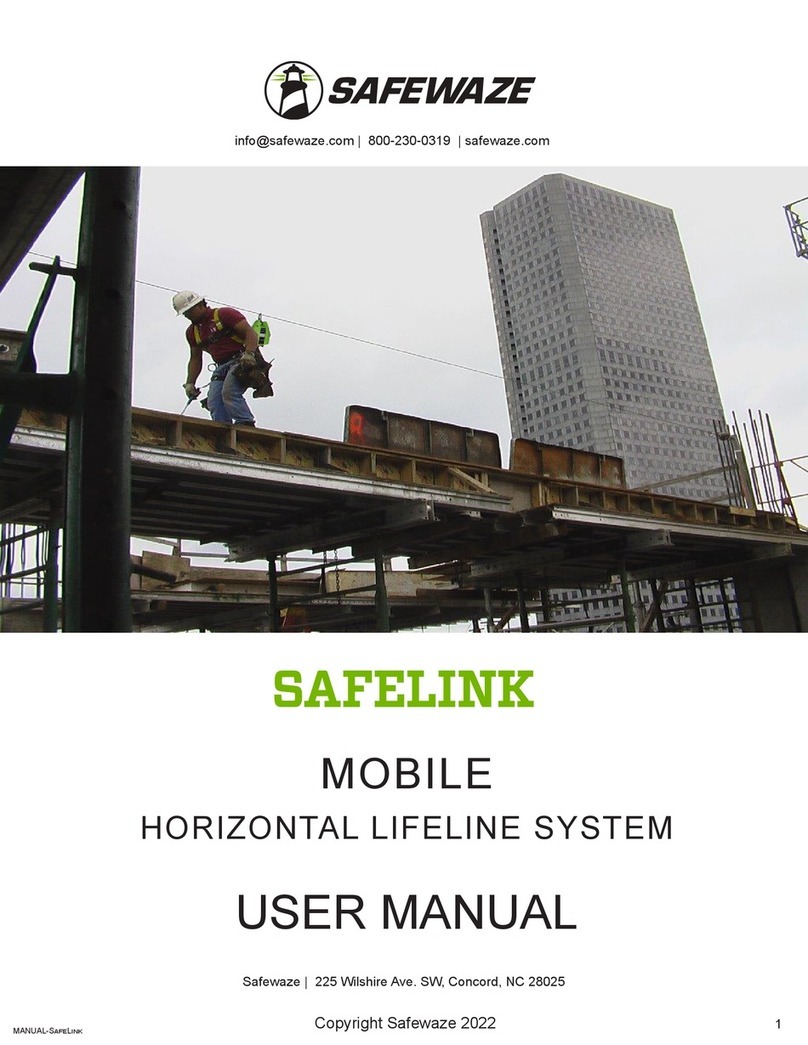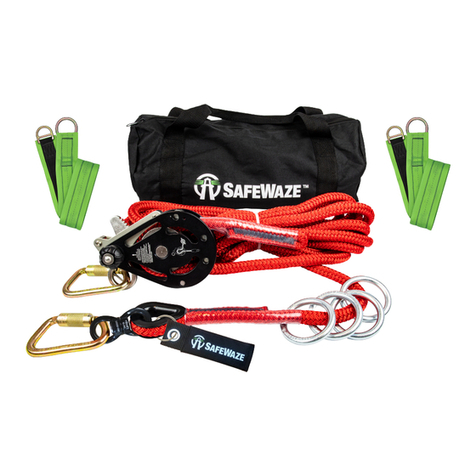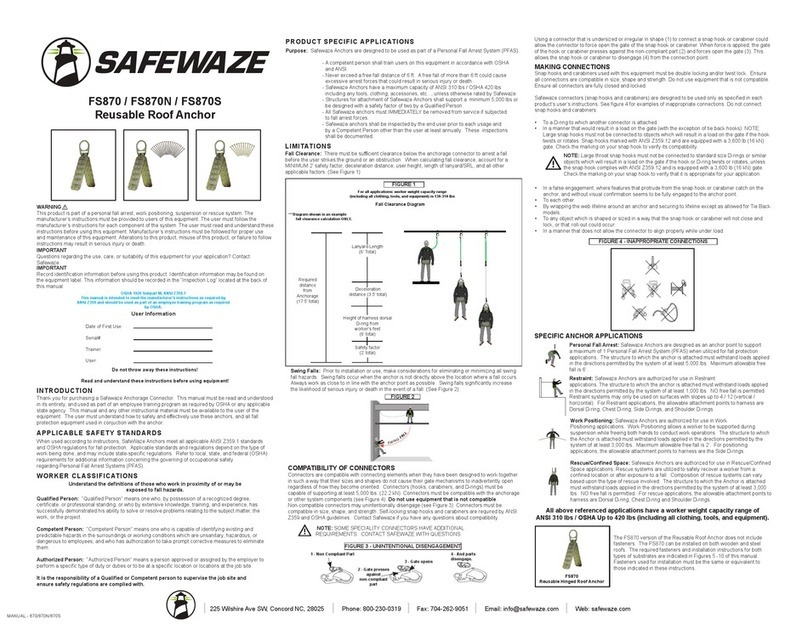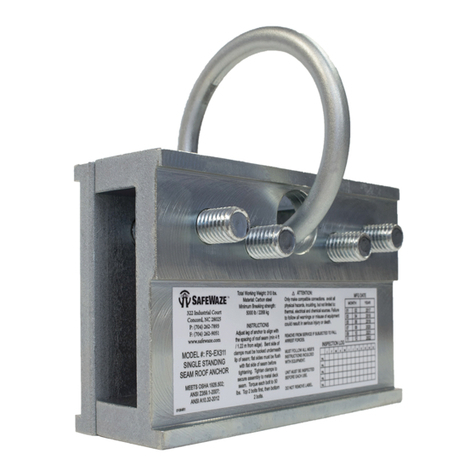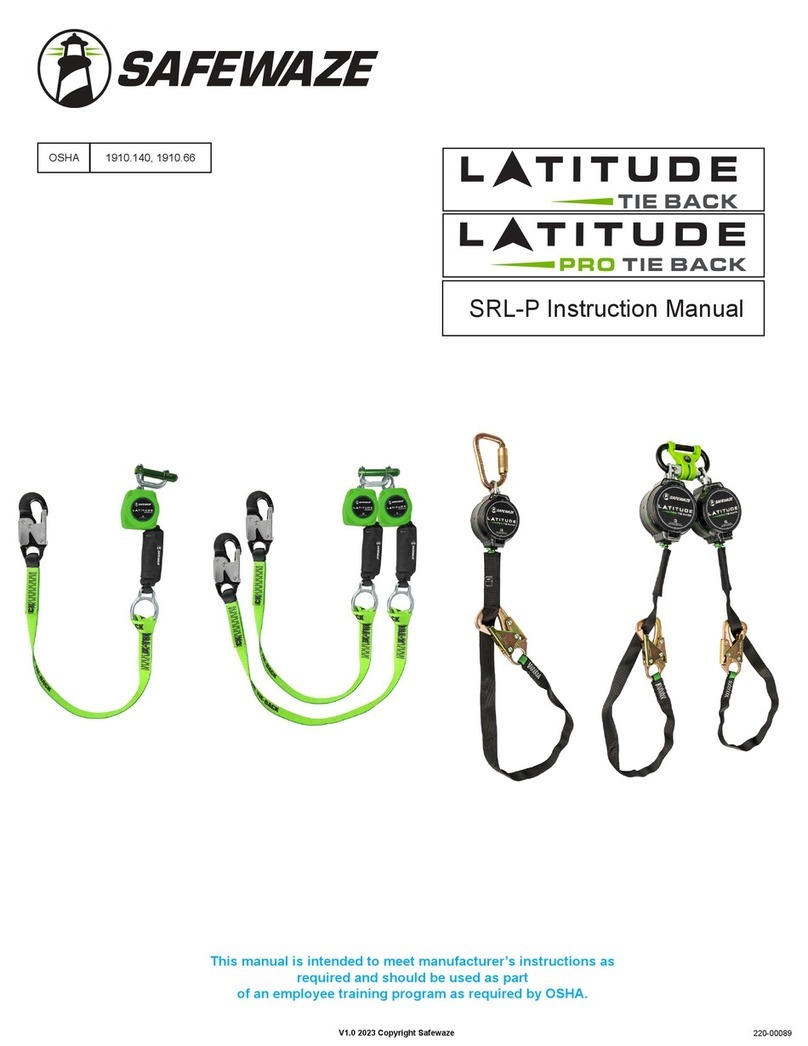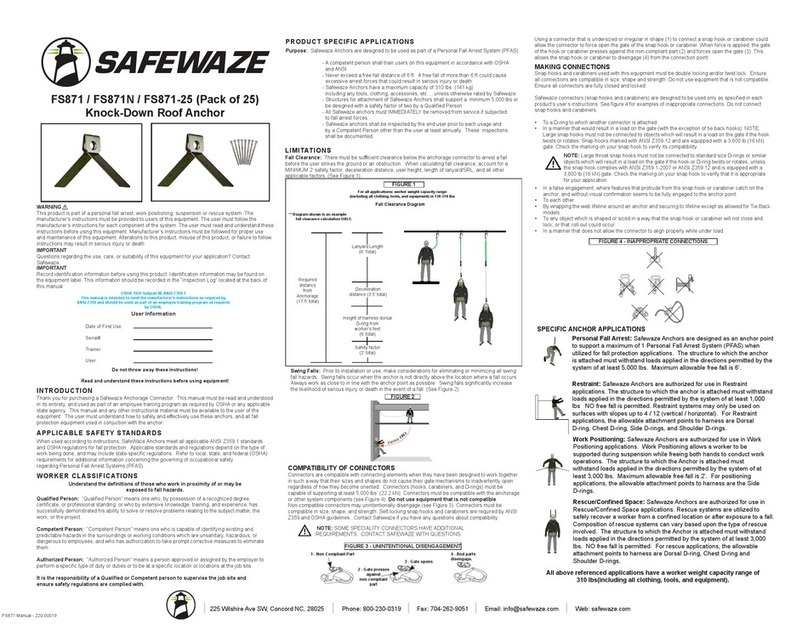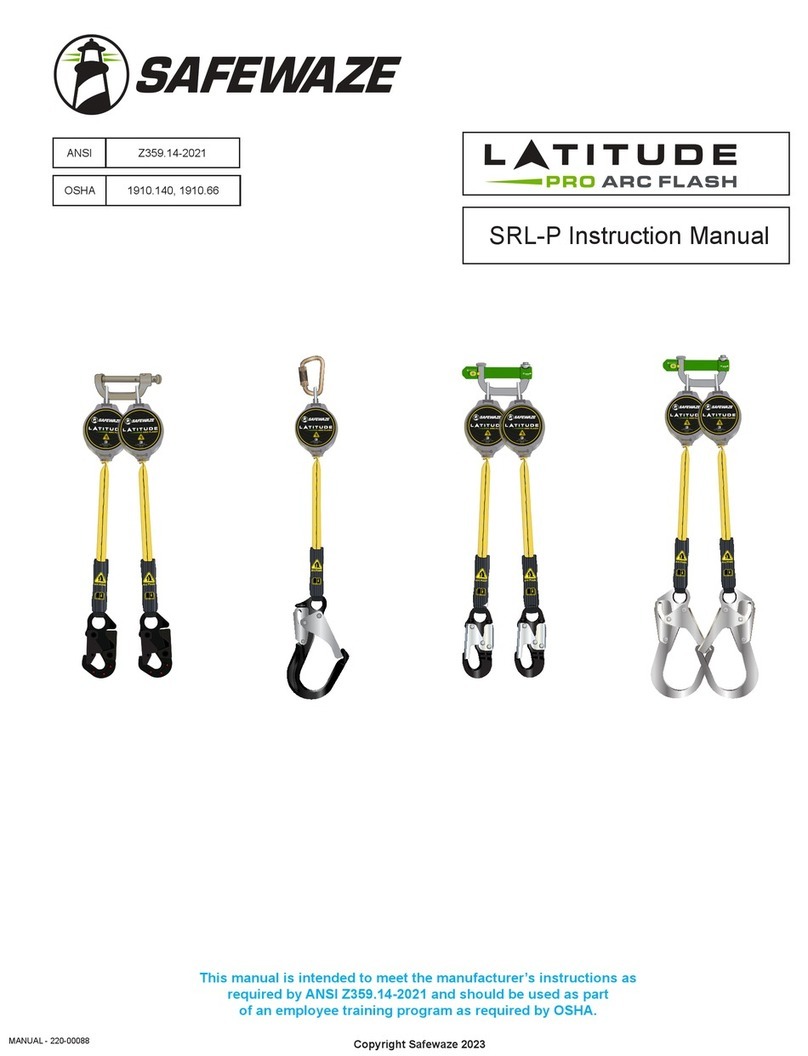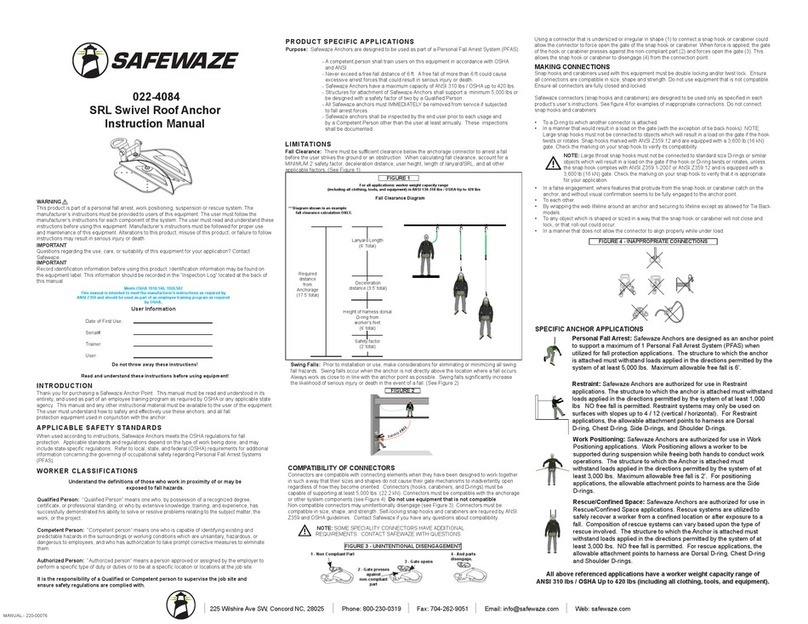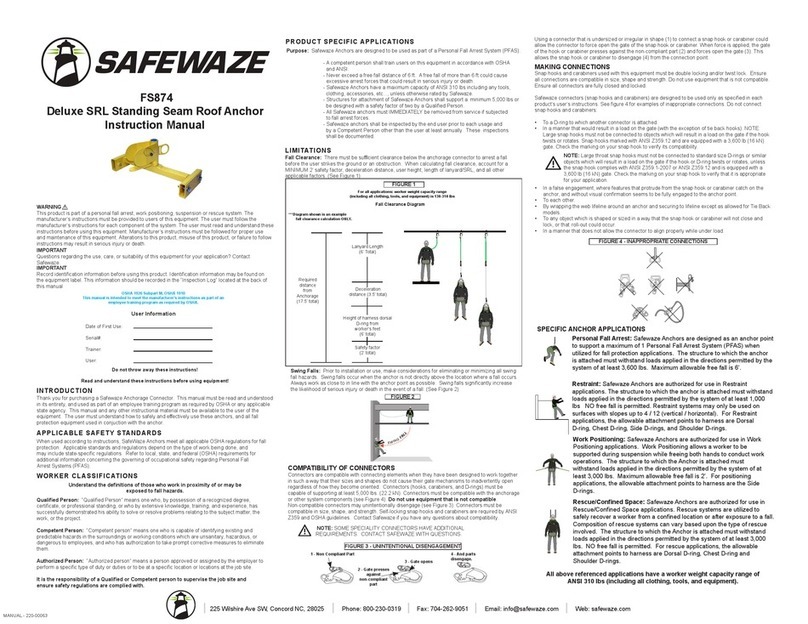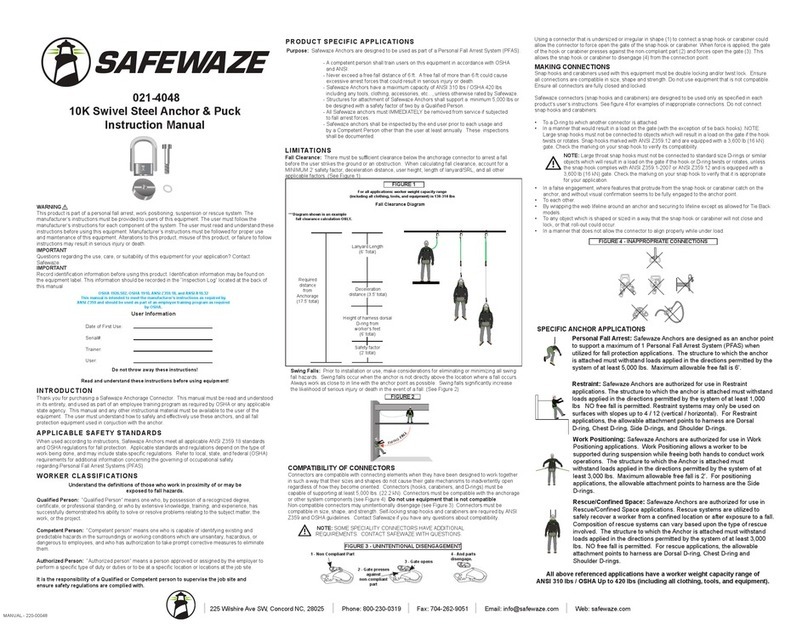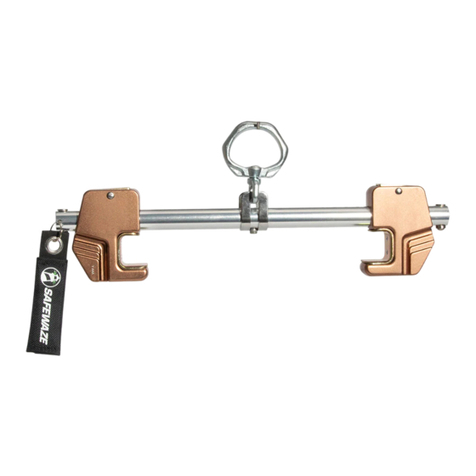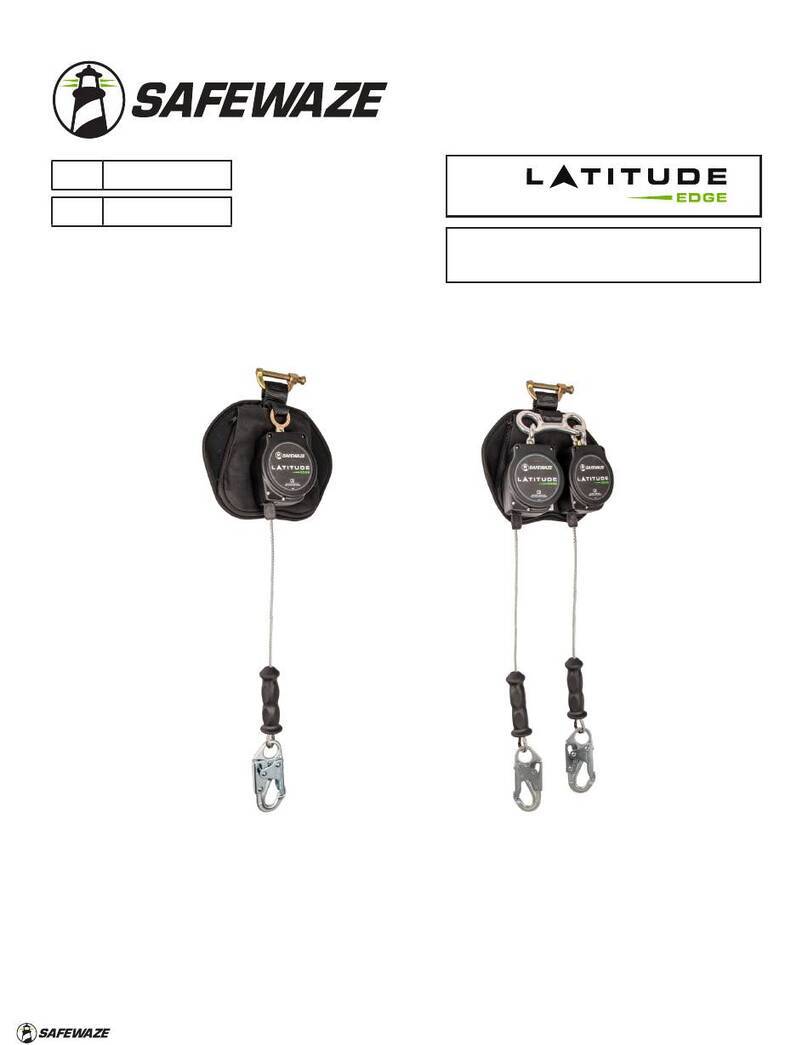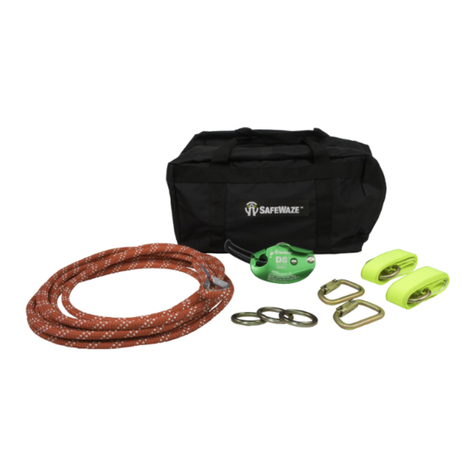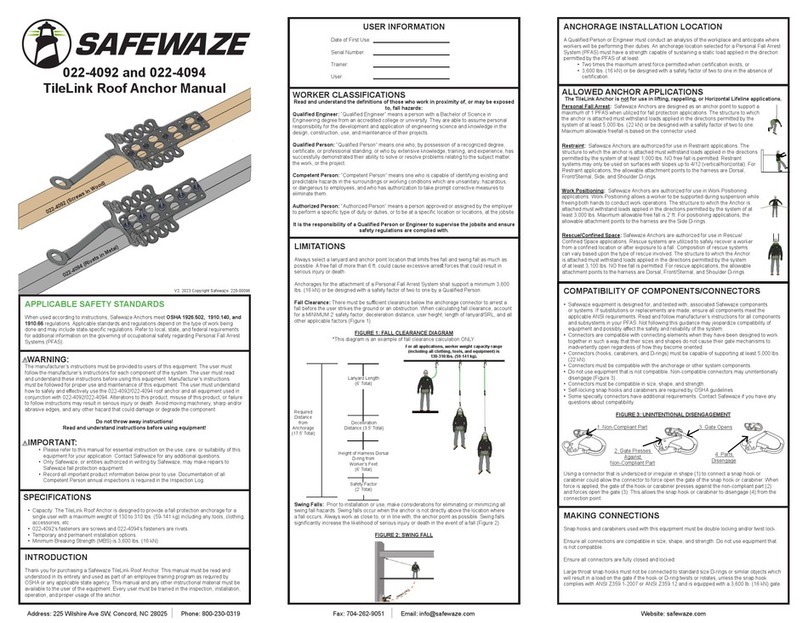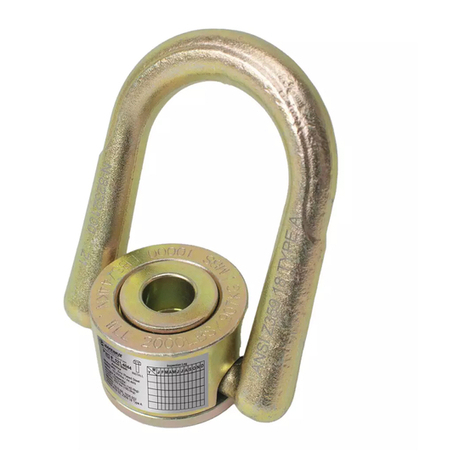
225 Wilshire Ave SW, Concord NC, 28025 Phone: 800-230-0319 Email: [email protected] Web: safewaze.comFax: 704-262-9051 II I I I
YES
Y
E
S
INSTALLATION PARALLEL INSTALLATION
PERPENDICULAR INSTALLATION
FS870N ANCHOR COMPONENTS FS870S ANCHOR COMPONENTS WARNING
• Users should consult with their doctor to verify ability to safely absorb the forces of a fall arrest event.
Fitness level, age, and other health conditions can greatly aect an individuals ability to withstand fall
arrest forces. Women who are pregnant, individuals considered minors must not use any Safewaze
equipment.
• Never alter any part of an anchor or add/remove components. Safewaze shall not be held
responsible for injury or death due to tampering.
• Anchors that are exposed to fall arrest forces MUST be IMMEDIATELY removed from service and
destroyed.
• Failure to follow these instructions and warnings could result in serious injury or death in the event
of a fall.
• A preplanned rescue procedure in the event of a fall is required. The rescue plan must be specic to
the project. The rescue plan must allow for employees to rescue themselves, or to be promptly rescued
by alternative means.
• Harnesses or connectors selected for use with any Safewaze anchor must be compatible in size and
conguration. User must ensure compatibility of snap hooks, carabiners and other connectors. Any
connection which could allow disengagement must be eliminated. Snap hooks and carabiners must be
self locking and self closing and must never be hooked to each other.
• A Competent Person must conduct an analysis of the workplace and anticipate where workers will be
conducting their duties, the route they will take to reach their work, and the existing and potential fall
hazards they may be exposed to. The Competent Person must choose the fall protection equipment
to be utilized.
• Do not misuse equipment.
• Equipment designated for fall protection must never be used to lift, hang, support or hoist tools or
equipment unless specically certied for such use.
• Safewaze Anchors shall be inspected prior to each use by the user, and at least annually by a
Competent Person other than the user. Annual inspections shall be documented. Severity of conditions
during use may necessitate increased frequency of documented inspections.
• Anchors that fail inspection MUST be removed from service.
• Prior to each use, inspect the anchor for deciencies or damage, including, but not limited to, sharp
edges, rough edges, deformations, corrosion, pits, burrs, chemical exposure, extreme heat exposure,
kinked, bird nested, or otherwise damaged cable, and damaged, missing or illegible labels. If any
deciencies or defects are found, the anchor must IMMEDIATELY be removed from service.
• The anchor must be inspected at least annually by a Competent Person other than the user.
Competent person inspections must be recorded in the inspection log included in this manual and
on the inspection grid label on the anchor.
INSPECTION
MAINTENANCE & STORAGE
WARRANTY
Anchor can be cleaned with water and mild soap if necessary. User should remove all dirt, possible
corrosives, and contaminants from the anchor prior to, and after each use. Never use any type of
corrosive substance to clean the anchor.
Excess water should be blown out with compressed air. Hardware can be wiped o with a clean, dry
cloth.
When not in use, store the anchor in a cool dry area where it will not be exposed to extreme light,
extreme heat, excessive moisture, or possibly corrosive chemicals or materials.
Safewaze warrants its products are free from defects in materials and construction under normal use
and service. Liability is not accepted for abuse, modication, improper use, destructive activity and
contaminated exposure.
INSPECTION LOG
Date Inspection Items
Noted
Corrective Action Initials
LABELS
1. The FS870N is installed over and into a roof truss at the peak, or in the eld of the roof
(See Figure 6, Dwg. 1 and Dwg. 3).
2. The work location should be free of debris, and other materials or equipment that could
interfere with the proper installation or operation of this equipment.
3. Inspect the substrate to which the anchor will be attached. User should inspect for the following
hazards. These hazards include, but are not limited to: rot, cracks, severe weathering, soft or
deteriorated areas in the sheathing, or damage from severe weather.
4. Installation of the FS870N requires that fasteners penetrate both the substrate and the truss.
Substrate must be a minimum of 3/4” CDX plywood. Fasteners must go through the sheathing and
penetrate the truss at least 1-1/2”. Do not install or use the FS870N on either the truss or sheathing
independently. Installation must capture both the sheathing and truss. The FS870N must be installed a
minimum of 5’ from any edge. NOTE: If the wood sheathing is of a thickness of 1-1/2” or greater, then
the FS870N can be installed into the sheathing only. ALL holes must be used.
5. To install with nails, position the anchor over previously secured roof sheathing (do not attach directly
the rafter or truss member). The roof anchor must be placed with the center holes lined up directly
over a framing member. Drive the nails through the center holes on both plates through the sheathing
and directly into framing member. To complete installation, additional nails must be installed in the
outer holes of each leg. Refer to Figure 7 which indicates all required holes lled to complete anchor
installation.
6. Ensure all required holes are lled and nails are fully installed. Installation on a wooden structure
restricts the users allowable work zone in relation to the anchor’s location. Figure 8 indicates
the allowable load conditions for the FS870N. DO NOT attach a lifeline between two or more FS870N
anchors (i.e, Horizontal Lifeline System).
7. PFAS connecting device can now be connected to the FS870N.
1. The FS870S can be installed in a parallel or perpendicular orientation to a metal roof/decking.
2. The work location should be free of debris, and other materials or equipment that could
interfere with the proper installation or operation of this equipment. User must ensure minimum
substrate requirements are met. Minimum 22 gauge metal roong/decking over minimum 16 gauge
Z-purlin.
3. Inspect the steel to which the anchor will be attached. User should inspect for the following hazards.
These hazards include, but are not limited to, excessive corrosion, cracks, severe rust, excessive
paint, or degradation due to intense heat or chemical exposure.
4. When installing the FS870S in a parallel conguration, the anchor must be installed to the crown of
the metal roof/decking. The FS870S MUST NOT be installed into the trough of the metal roof/decking.
The FS870S must be installed a miminum of 5’ from any edge.
5. Install the (12) 2-1/2” Sheet Metal Screws in the center row of pre-drilled holes on each leg of the
anchor (6 screws per leg / See Figure 10, Dwg. 1).
6. The sheet metal screws must penetrate both the metal sheeting AND the purlin. Never install or use
anchor attached to the sheeting only, or to the purlin only. DO NOT attach a lifeline between two or
more FS870S anchors (i.e., Horizontal Lifeline System).
7. PFAS connecting device can now be connected to the FS870S.
8. When installed in this conguration, the FS870S can sustain loads in all directions.
1. Follow Steps 1 through 3 as indicated in Parallel installation.
2. When installing the FS870S in a perpendicular conguration, the anchor must be installed to the
crown of the metal roof/decking. Wood support members must also be used. The support members
are placed in the trough(s) of the roof/decking. Place the FS870S perpendicularly across the crown(s)
of the decking and across wood support members (See Figure 10, Dwg. 2). The FS870S must be
installed a minimum of 5’ from any edge.
3. Install the (12) 2-1/2” Sheet Metal Screws in the center row of pre-drilled holes on each leg of
the anchor (6 screws per leg / See Figure 10, Dwg. 2). Anchor should be placed to ensure the
screws pentrate both the metal sheeting AND the purlin, or are installed into the wood
support members (See Figure 10, Dwg 2). DO NOT attach a lifeline between two or more FS870S
anchors (i.e.
4. PFAS connecting device can now be connected to the FS870S.
5. When installed in this conguration, the FS870S can sustain loads in all directions.
FIGURE 5 - ANCHOR COMPONENTS FIGURE 9 - ANCHOR COMPONENTS
FIGURE 7 - NAIL INSTALLATION DIAGRAM FIGURE 8 - ALLOWABLE LOAD CONDITIONS
FIGURE 6 - INSTALLATION (WOOD)
FIGURE 10 - INSTALLATION (METAL)
B B
C C
D D
A A
Dwg. 1
Dwg. 1 Dwg. 2
Anchor Components
A Fall Protection Connection Point
B Hinge
C Pre-drilled Fastener Holes
D Anchor Leg
E (20) 16d Steel Nails
Anchor Components
A Fall Protection Connection Point
B Hinge
C Pre-drilled Fastener Holes
D Anchor Leg
E (12) 2-1/2” Sheet Metal Screws
Replacement Components Replacement Components
021-4065 021-4066
FS870N
Reusable Hinged Roof Anchor
FS870N
Reusable Hinged Roof Anchor
YES
YES
Dwg. 3 Dwg. 4
NO
N
O
N
O
N
O
E E
Dwg. 2
REUSABLE ROOF ANCHOR
INSTRUCTIONS:
MUST Inspect all anchor points prior to use for
damage and / or deformations. Attach only to
structure member or material that will
support 5000 lbf.
When attaching to metal decking roofs, the
material must be a minimum thickness of 22 gauge
over Z-purlins with a minimum thickness of 16
gauge. Twelve1/4-14 Teks screws are required to
beyond the bottom of the purlin.
User must follow all mfg’s instructions included with this
equipment. Maximum working load: 310 lbs. (single user)
Only make compatible connections. Remove from service
if subjected to fall arrest forces. Avoidall physical hazards
including, but not limited to,
thermal, electrical and chemical sources.
DO NOT REMOVE THIS LABEL
Material: Yellow Zinc Plated Steel
Meets: OSHA 1910.140 & OSHA 1926.502
www.safewaze.com
01072
FS870FS870N FS870S
When attaching to wood truss over sheathing,
center row holes of both sides must be secured
using 16D nails or 12 X 1/4-14 Teksscrews,
through sheathing and into truss (Use either nails or
screws). : 6 per leg. Remaining holes (10 per side)
must be used to secure anchor to roof structure.
See instruction manual for specific installation
instructions.


